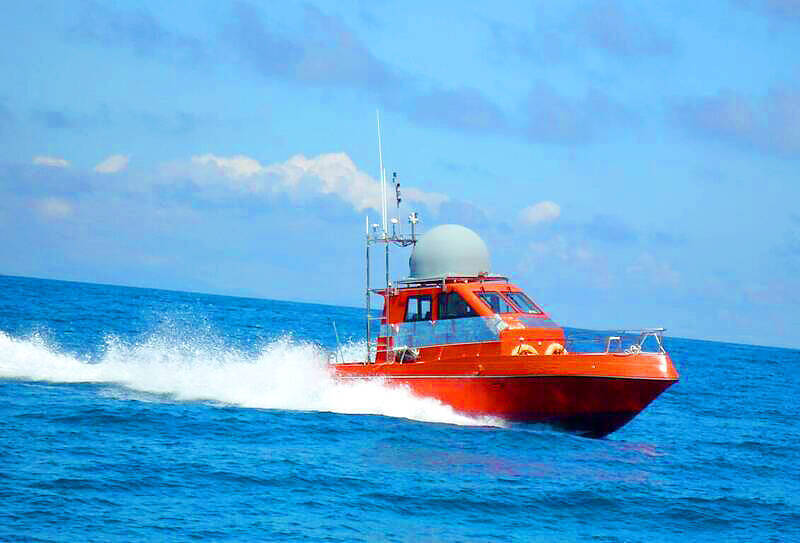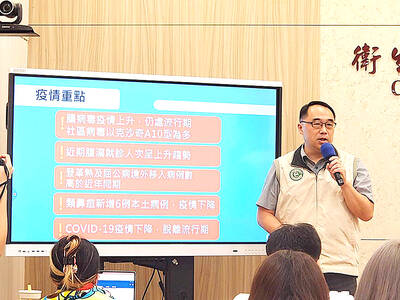The Ministry of National Defense is aiming to bolster the military arsenal by procuring four specific types of attack drones, a senior military official said on the condition of anonymity.
The drones include ones designed to execute short-range strikes, carry loitering munitions, take off and land vertically while changing flight attitude, and carry ammunition similar to a missile, but have extremely low costs.
Drones that can execute short-range strikes could launch direct attacks on the enemy, while those that are able to carry loitering munitions on board could carry out “suicide” attacks after locking in targets, the source said.

Photo: Screen grab from the institute’s Web site
The ministry has purchased four MQ-9B drones and 685 Switchblade 300 drones from the US. It also tasked the Chungshan Institute of Science and Technology (CSIST) to build Teng Yun (騰雲) drones and Chien Hsiang (劍翔) loitering munitions.
Meanwhile, the ministry tasked private contractors to build commercial drones for military use, which would enhance survivability and reconnaissance capabilities.
The CSIST is producing 200 second-generation Chien Hsiang drones, which can conduct cross-strait warfare with their ability to fly up to 1,000km. The Cat 1 loitering munition can be carried by individual soldiers, while Cat 2 can be installed on motor vehicles and ships.
Separately, the CSIST is scheduled to begin trials in June for uncrewed attack boats as part of the Kuachi Project (快奇專案), in which private contractors would be invited to participate, a source familiar with the matter said.
The project was launched to counter Chinese military expansion and “gray zone” harassment by enhancing asymmetric warfare capabilities. China has intensified its harassment against Taiwan, intending to exhaust the military and coast guard.
The project’s goal is to develop uncrewed attack boats that could carry explosives and be remotely controlled. The boats are scheduled to begin mass production next year, if they pass operational tests and evaluations by the end of this year. Private contractors such as Lungteh, Jong Shyn and CSBC would be invited to send their vessels for the trial, when the functions of the CSIST-produced uncrewed attack boats would be tested, the source said.
Results of the trial would affect subsequent research and development efforts, as well as mass production, they said.
In related news, the navy yesterday said that drills in waters southwest of Pingtung County scheduled for March 24 are “routine” exercises and would not involve live-fire training.
Local media had suggested that the exercises, which were announced by the navy on Thursday last week, could target an area in which alleged Chinese-owned ships flying flags of convenience have spent extended periods in recent days.
The coast guard should be able to “handle” the six vessels in waters around Taiwan, said Su Tzu-yun (蘇紫雲), research fellow and director of the Division of Defense Strategy and Resources at the Institute for National Defense and Security Research.
“The traditional division of labor between the coast guard and navy is based on a 24 nautical mile [44.4km] boundary,” Su said, adding that the coast guard controls waters within 24 nautical miles of Taiwan’s coastline, while the navy is responsible for the area beyond.
“However, when there are many targets and the frequency is high, the coast guard and navy support each other’s missions,” Su said.
The drills might be related to underwater infrastructure, including submarine telecommunications cables or power lines connecting offshore wind turbines, Su said.
Additional reporting by CNA

A magnitude 4.9 earthquake struck off Tainan at 11:47am today, the Central Weather Administration (CWA) said. The hypocenter was 32.3km northeast of Tainan City Hall at a depth of 7.3km, CWA data showed. The intensity of the quake, which gauges the actual effect of a seismic event, measured 4 in Tainan and Chiayi County on Taiwan's seven-tier intensity scale, the data showed. The quake had an intensity of 3 in Chiayi City and County, and Yunlin County, while it was measured as 2 in Kaohsiung, Nantou County, Changhua County, Taitung County and offshore Penghu County, the data showed. There were no immediate reports of

Weather conditions across Taiwan are expected to remain stable today, but cloudy to rainy skies are expected from tomorrow onward due to increasing moisture in the atmosphere, according to the Central Weather Administration (CWA). Daytime highs today are expected to hit 25-27°C in western Taiwan and 22-24°C in the eastern counties of Yilan, Hualien, and Taitung, data on the CWA website indicated. After sunset, temperatures could drop to 16-17°C in most parts of Taiwan. For tomorrow, precipitation is likely in northern Taiwan as a cloud system moves in from China. Daytime temperatures are expected to hover around 25°C, the CWA said. Starting Monday, areas

A Taiwanese software developer has created a generative artificial intelligence (AI) model to help people use AI without exposing sensitive data, project head Huang Chung-hsiao (黃崇校) said yesterday. Huang, a 55-year-old coder leading a US-based team, said that concerns over data privacy and security in popular generative AIs such as ChatGPT and DeepSeek motivated him to develop a personal AI assistant named “Mei.” One of the biggest security flaws with cloud-based algorithms is that users are required to hand over personal information to access the service, giving developers the opportunity to mine user data, he said. For this reason, many government agencies and

Taiwan has recorded its first fatal case of Coxsackie B5 enterovirus in 10 years after a one-year-old boy from southern Taiwan died from complications early last month, the Centers for Disease Control (CDC) said yesterday. CDC spokesman Lo Yi-chun (羅一鈞) told a news conference that the child initially developed a fever and respiratory symptoms before experiencing seizures and loss of consciousness. The boy was diagnosed with acute encephalitis and admitted to intensive care, but his condition deteriorated rapidly, and he passed away on the sixth day of illness, Lo said. This also marks Taiwan’s third enterovirus-related death this year and the first severe